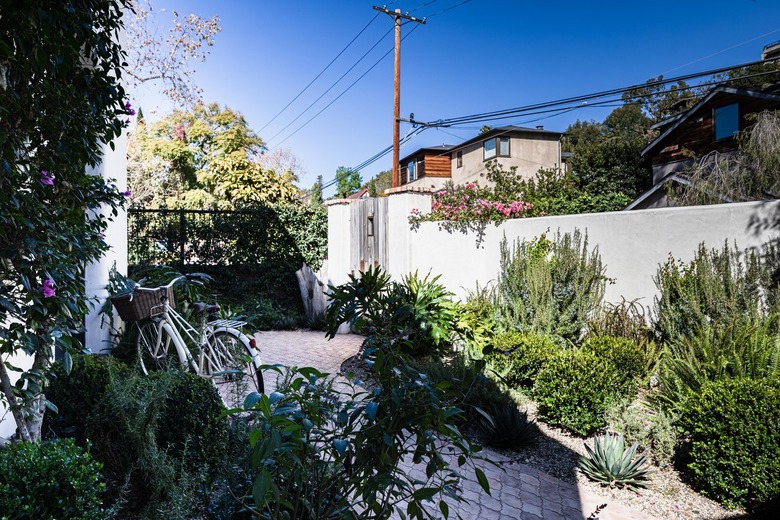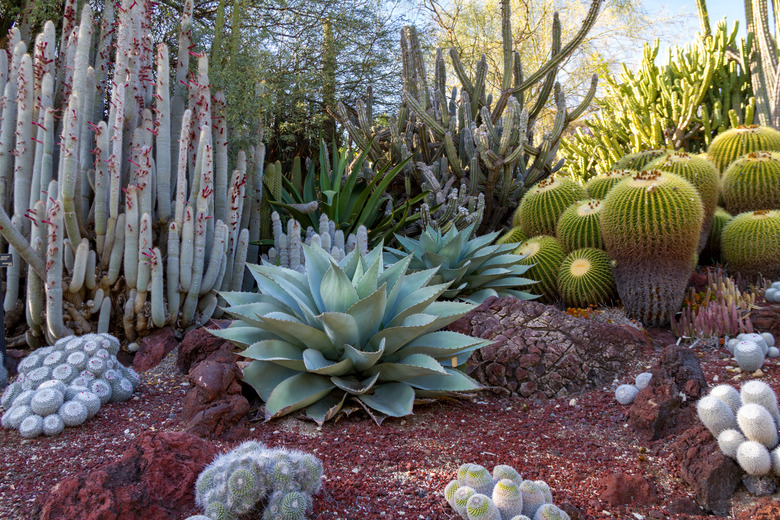The Pros And Cons Of Landscape Fabric
We may receive a commission on purchases made from links.
For many homeowners, landscape fabric is the go-to material for suppressing weeds and keeping weeding chores at a minimum throughout the growing season. It works well for stopping weeds, especially when it is first applied, but it is not a miracle product, and there are some drawbacks to using it in the garden.
Landscape Fabric Basics
Landscape Fabric Basics
Two qualities make landscape fabric attractive to gardeners. Once applied to prepared garden soil, the fabric blocks sunlight from reaching weed seeds that may be in the soil, preventing them from germinating. At the same time, the material allows water and air to pass through it and reach the roots of the plants in the garden.
Most commercially available landscape fabric products are made of polypropylene, polyethylene, polyester or some combination of those materials. Some products are made from pieces of material woven together on a loom. They are called woven fabrics. Nonwoven landscape fabric consists of materials that are bonded together. Spunbond fabric is a type of nonwoven material that is stronger than standard nonwoven products.
Products vary from manufacturer to manufacturer, but in general, woven products tend to be stronger than nonwoven. In addition to garden use, woven fabrics are often used as underlayment for walkways, patios and driveways. Nonwoven landscape fabric allows the passage of water and air more readily than woven fabrics, although it tears more easily than woven products. Both types of products will suppress weeds when properly applied.
It can get confusing, but when you are shopping, just look for the intended use on the product's label. Landscape fabric that you would buy at a home center or garden center comes in rolls that are 3 or 4 feet wide and up to 100 feet long.
Uses for Landscape Fabric
Uses for Landscape Fabric
Landscape fabric can be used in a number of different ways. For ornamental gardens and plantings, the fabric is laid on top of the prepared soil and is held in place with landscape fabric pins or staples. The gardener cuts holes in the fabric to insert the plants and then covers the fabric with a few inches of mulch. The fabric stays in place from year to year, and many people consider it a permanent solution for a weed problem, although it does deteriorate over time.
Sometimes, when appearance is not an issue, gardeners leave the landscape fabric exposed. They simply cut an X in the fabric and insert the plants into the soil. This method is usually confined to vegetable gardens. This type of installation usually only lasts one growing season. Although you should note that when the landscape fabric is exposed, it is important to choose a fabric that is resistant to ultraviolet light because the raw materials used in the fabrics degrade in sunlight.
Other uses of landscape fabric include weed suppression under walkways and patios, especially when they are built on a gravel and sand base. It is also used as a separator to keep soil away from drainage areas, such as dry creek beds and the areas behind retaining walls. Landscape fabric does a good job as a weed barrier for any hardscaping, including loose stone walks.
Pros and Cons of Landscape Fabrics
Pros and Cons of Landscape Fabrics
Besides suppressing weed growth, landscape fabrics have other advantages for savvy gardeners.
- They reduce the need for chemicals to control weeds, sometimes eliminating their use altogether.
- They reduce moisture evaporation from the soil, which means less watering.
- They last a long time in most cases, so in many cases, there is no need to repeat the installation process every year.
- They are an improvement over the use of plain plastic sheets to which many people resorted in the past. Plain plastic does not allow for the passage of water and air to the root zone of plants.
- Professional landscapers use landscape fabrics on slopes to reduce erosion.
The use of landscape fabrics in gardens does have some drawbacks, however.
- Landscape fabric starts to lose its weed suppression qualities over time if it is cut year after year to add new plants. Weeds are opportunistic and will find a way through the openings no matter how small they are.
- The nutrients from the breakdown of organic mulches, such as wood chips, grass clippings and leaves, cannot penetrate the barrier to get to the soil below.
- Organic mulches can support the growth of weed seeds that find their way into the garden. The weeds will not only grow but their roots can penetrate the fabric barrier, making them very difficult to remove.
- Earthworms and soil-enhancing organisms cannot get through the fabric to enrich the soil below.
- Over time, soil and mulch can clog the small holes in the fabric, preventing the flow of water to the soil.
Alternatives to Landscape Fabric
Alternatives to Landscape Fabric
Many gardening experts believe that the proper application of mulch alone does a fine job of limiting weed growth. Wood chips will break down over time. While grass clippings and shredded leaves may not work in a formal setting, they are fine for casual gardens, and they are free.
There are landscape-fabric-type materials that are biodegradable. These materials will break down and replenish the soil, which means they must be replaced every year or two. Some gardeners use plain newspaper or cardboard as underlayment for mulch. If you do use newspapers, be sure to avoid the glossy advertising supplements and magazines, which won't break down to enrich the soil. To install, lay the paper two or three pages thick and overlap the edges. Cover the paper or cardboard with a layer of mulch. Until the paper or cardboard begins to degrade, however, it may form an impenetrable barrier that prevents water and fertilizer from reaching the soil beneath it.
For some gardeners, using a poly landscape weed barrier is too convenient to give up, especially when they are planting annuals. However, the annual planting in the spring and the removal of dead plants in the fall takes a toll on the fabric, and it lasts only a year or two. In those cases, it is a good idea to work organic matter into the soil before installing the landscape fabric.

